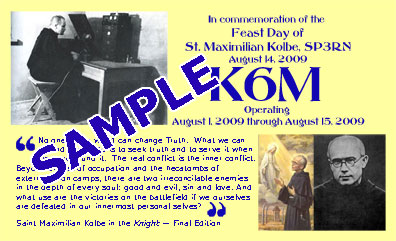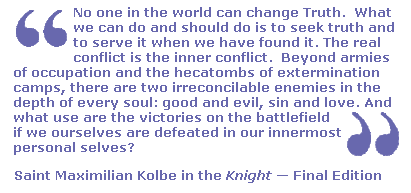
OPERATING HOURS
August 1, 2009 through August 15, 2009
from 7:00 am PST (1400Z) to 4:59 pm PST (2359Z)
Actual operation dependent on operator availability.
Check this site for changes to operating schedule.
FREQUENCIES:
20 Meters - 14.275 MHz
40 Meters - 7.275 Mhz
80 Meters - 3.825 MHz
2 Meters - 146.535 MHz
The Story of
St. Maximilian Kolbe
St. Maximilian Kolbe was born Rajmund Kolbe on January 8, 1894 in Zduńska Wola, which was then part of the Russian Empire. His father, Julius Kolbe, was an ethnic German. His mother, Maria Dabrowska, who was Polish, formed Maximilian with daily recitation of the Angelus, the litany and the Holy Rosary.
Rajmund was a mischievous young boy and one day he was reprimanded by his mother, who wondered what would become of him if he persisted in his mischief. He prayed to Our Lady of Czestochowa, asking what would become of him, and he received a vision which he later described in the following words:
"That night, I asked the Mother of God what was to become of me. Then she came to me holding two crowns, one white, the other red. She asked me if I was willing to accept either of these crowns. The white one meant that I should persevere in purity, and the red that I should become a martyr. I said that I would accept them both."
In 1907 Kolbe and his elder brother Francis decided to join the Conventual Franciscans, entering the Conventual Franciscan junior seminary in Lwów. In 1910 Kolbe entered the novitiate. He professed his first vows in 1911, adopting the name Maximilian, and his final vows in 1914, in Rome, adopting the names Maximilian Maria, to show his veneration of the Blessed Virgin Mary.
In 1912 he was sent to Kraków, and in the same year to Rome, where he studied philosophy, theology, mathematics, and physics. He took a great interest in astrophysics and the prospect of space flight and the military. While in Rome he designed an airplane-like spacecraft, similar in concept to the eventual space shuttle, and tried to patent it. He earned a doctorate in philosophy in 1915 at the Pontifical Gregorian University, and the doctorate in theology in 1919 at the Pontifical University of St. Bonaventure.
In 1918 Kolbe was ordained a priest. In 1919 he returned to the newly independent Poland, where he was very active in promoting the veneration of the Immaculate Virgin Mary, founding and supervising the friary of Niepokalanów (the "City of the Immaculate") near Warsaw, a seminary and several other organizations and publications. Fr. Kolbe published a Christian periodical in Poland which was eventually headquartered out of the newly established friary. He became the friar superior in 1936.
On December 8, 1938 - the Feast of the Immaculate Conception - Fr. Kolbe opened radio station SP3RN. The SP3RN callsign broke down as follows:
SP - designating the country of Poland
3 - designating the region within Poland
RN - designating Radio Niepokalanów
The exact type of radio station is unclear. It is variously described as a shortwave station, a broadcast station or an amateur radio station. The station broadcast sermons by Fr. Kolbe, as well as music from the friary's orchestra. It is likely that Fr. Kolbe, with his technical background, was the designer and operator of the station, as well as one or more amateur radio stations at the friary. He used his amateur radio skills to vilify Nazi activities through his reports.
Fr. Kolbe anticipated that the Nazis would invade Poland, and by the time they did in 1939, he had already sent away 700 of his friars. Only he and a small group of priests remained behind. On September 19, 1939, Fr. Kolbe and 35 other members of the order were arrested. They were released on December 8, 1939, but were prohibitted from any further publications or broadcasts. Fr. Kolbe apparently made repeated requests of the Nazis to resume publication and broadcast operations.
For the following year, Fr. Kolbe provided shelter to refugees from Greater Poland, including approximately approximately 2,000 Jews whom he hid from Nazi persecution in his friary in Niepokalanów. The Gestapo suspected he was aiding and abetting the "enemy", but they didn't have proof. In December 1940, The Nazis decided to grant one of Fr. Kolbe's request to resume publication in order to have him incriminate himself. He published one more issue of the "Knight of the Immaculate Mother".
Fr. Kolbe was also a ground-breaking theologian. His insights into the Immaculate Conception anticipated the Marian theology of the Second Vatican Council and further developed the Church's understanding of Mary as "Mediatrix" of all the graces of the Trinity, and as "Advocate" for God's people. Only hours before the Gestapo arrived to arrest him, he completed his final and most comprehensive theological essay on the Virgin Mary's identity as one who is perfectly united to the Holy Spirit by a bond of love.
On February 17, 1941 Fr. Kolbe was arrested by the German Gestapo on the charge of aiding the Jews and the Poles. He was imprisoned in the Pawiak prison, and on May 28 he was transferred to Auschwitz as prisoner #16670.
In July 1941 a man from Kolbe's barracks vanished. SS-Hauptsturmführer Karl Fritzsch, the deputy camp commander, picked ten men from the same barracks to be starved to death in Block 13. Similar to the Roman army's practice of decimation, it was an effort to deter further escape attempts. (The man who had disappeared was later found drowned in the camp latrine.) One of the selected men, Franciszek Gajowniczek, cried out, lamenting his family, and Kolbe volunteered to take his place. He stepped forward, saying: “I am a Catholic priest. I wish to die for that man. I am old; he has a wife and children.”
Fr. Kolbe led the condemned men in songs and prayer during their time in the death cell. After three weeks of dehydration and starvation, only Kolbe and three others were still alive. He encouraged others that they would soon be with Mary in heaven. Each time the guards checked on him he was standing or kneeling in the middle of the cell and looking calmly at those who entered, while the others lay moaning and complaining, on the ground around him. Finally he was killed with an injection of carbolic acid. Some who were present at the injection say that he raised his left arm and calmly waited for the injection. He became a silent key on August 14, 1941. His remains were cremated on the feast day of the Assumption of Mary.
He was beatified on October 17, 1971 by Pope Paul VI who called him “St. Francis come alive in our time.” He was canonized by Pope John Paul the Great on October 10, 1982, in the presence of Franciszek Gajowniczek, the man whose life Fr. Kolbe saved at Auschwitz. Until his death in 1995 at the age of 94, Gajowniczek spoke of the self-sacrificial love of St. Maximilian Kolbe and how that love had saved his life.
VIDEO
Resources
- St. Maximilian Kolbe Postcards and First Day Covers
- St. Maximilian Kolbe (SP3RN) - Wikipedia
- St. Maximilian Kolbe - 1A4A (The Amateur Radio Station of Malta)
- St. Maximilian Kolbe, SP3RN
- St. Maximilian Kolbe - Saints.SPQN.com
- St. Maximilian Kolbe - Jewish Virtual Library
- St. Maximilian Kolbe - Catholic Online
- St. Maximilian Kolbe - Saint of the Day
- St. Maximilian Kolbe, Martyr of Love - HLI
- Marytown, the National Shrine of St. Maximilian Kolbe
- St. Maximilian Kolbe - FatherKolbe.com
- Chaplet of St. Maximilian Kolbe - Prayerbook.com
- Novena Prayer to St. Maximilian Kolbe - EWTN
- K8M (Special Event) - Prince of Peace Amateur Radio Society - QRZ.com
- K8M (Special Event) - Listing at ARRL.org
- Who is St. Maximilian Kolbe - Consecration, Militia of the Immaculata
QSL CARDS

QSL cards must be mailed with an SASE to:
K6M
P.O. Box 18142
San Jose, CA 95158-8142
Certificates
Information on obtaining certificates will be coming soon.
